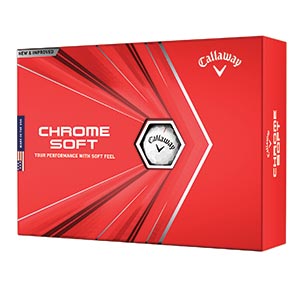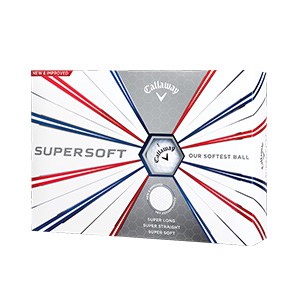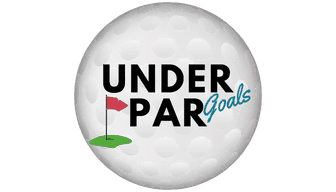Callaway has really gone all in with the low compression golf ball craze of recent years. So I took a look at two of their low compression balls, the premium model Chrome Soft and the affordable Supersoft.
We’ll look at some Chrome Soft vs. Supersoft numbers on Trackman and figure out if there’s a big difference and which one you should be playing.
Thanks to Golf Kings in Wall, NJ for letting me use their Trackman simulator for the testing.
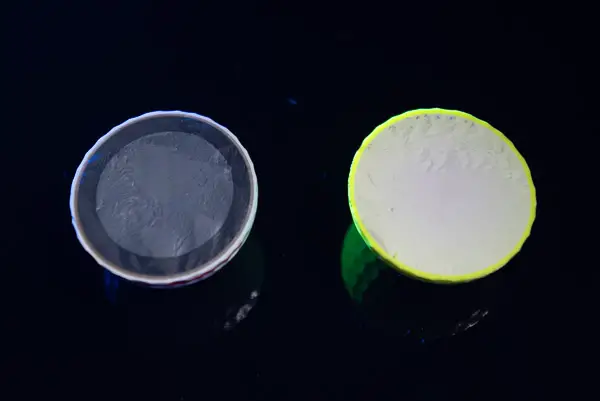
Callaway Chrome Soft
The Callaway Chrome Soft is a premium golf ball in the same category as the Pro V1, TP5 and Z-Star. It also comes with a premium price tag.
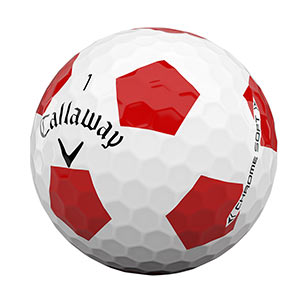
According to Callaway, the Chrome Soft was designed with a faster core for more distance. The inner core is larger than the previous version which should mean higher launch and less spin.
Callaway also made the outer cover thinner to reduce spin on full shots while retaining the short game spin that a premium golf ball needs for control around the greens. This balance between adding greenside spin and reducing driver spin is what just about every ball manufacturer is focusing on nowadays.
Callaway Supersoft
The Supersoft golf ball is a more affordable ball that is designed for higher handicap golfers with an emphasis on low compression, low spin, and keeping it straight.
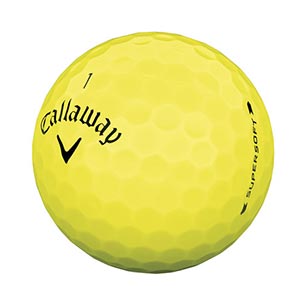
Despite the name, Callaway does consider this a “distance” ball…one that is designed for slower swing speeds. For years, we thought of distance balls as those rock hard, inexpensive golf balls that felt terrible. Although those balls would reduce spin and roll forever, the downside was that they weren’t soft enough for a lot of players to get any compression.
The Supersoft solves that problem for slower swing speeds. Callaway claims that the soft 35 compression core is also very low spin so the ball will carry farther and fly straighter.
However, it doesn’t have the soft urethane cover, so greenside spin on chips and pitches will be lower as well, making it hard to stop the ball when you want to.
Saving money on the cover does mean a price point that is much lower than the Chrome Soft. This is great for the average player that might lose a couple sleeves every round.
Now that you have an idea of what each ball is supposed to be, let’s look at how they match up head to head in each of the following categories…
Feel
Both of these golf balls feel soft, which, since they have the word soft in their name, makes sense.
However, there are some definitely differences in feel.
On any full shots, from wedge to driver, the Supersoft clearly has a softer feel off the club. With a 35 compression rating, this is to be expected. Full swings are going to activate that core and let you feel the differences in compression. The Chrome Soft, with a compression rating of 75, feels much more similar to a ProV1…soft off the club but not mushy like the Supersoft does with longer clubs and the driver.
Of course, feel is more personal and that mushy feeling is just my opinion. I actually quite liked how it felt with the wedges, so how good it feels to you may be dependent on your own preference and your swing speed.
And talking about swing speed…
Driver Distance
When you look at driver distance from a golf ball, there are two things to focus on, ball speed and spin rate.
Ball speed is a direct result of the speed of the clubhead and hitting the sweet spot of the club. However, the compression of the ball and the ball’s ability to transform the energy of the club into forward momentum of the ball makes a big difference as well.
Spin rate can also be affected by the club and the swing, but the ball itself can change that by enhancing the spin or reducing the spin.
To test these factors, I hit 12-15 driver shots with each ball on a Trackman, then removed the outliers like mishits so that the data would be more representative of the differences in the balls rather than the swing variation. I’m not a golf pro, but removing the mishits makes the results more consistent and representative of what an average golfer could expect (I repeated the process with 7 iron and a 54 degree wedge which I’ll get to below).
First let’s look at the shots with the Chrome Soft.
What I really liked was that the spin was very well controlled, even when my driver swing didn’t have as much of a positive angle of attack as I would like. Spin never got much above 2600rpm with most of the shots closer to 2000rpm. These are pretty good spin numbers and close to optimal.
I varied the swing speed a little to give you some more data points to look at. As you can see, the energy transfer (as indicated by “smash factor”) was decent throughout (with the exception of shot #7).
Note: 1.50 is a perfect smash factor and most PGA pros are looking for a 1.49
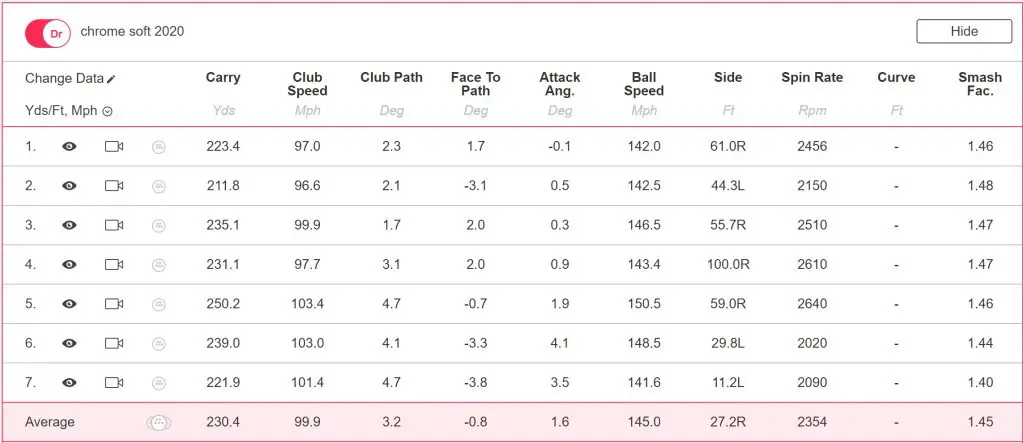
Now let’s take a look at the Supersoft.
With a 35 compression, it doesn’t take much to compress this ball. This makes it perfect for slower swing speed players who are going to be able to get the most out of their swing.
However, as you can see below, as the clubhead speed got higher, the smash factor went down. This meant that the ball was less efficient at converting the speed of the driver into forward momentum with higher swing speeds compared to the Chrome Soft.
However, if your swing speed is 95mph or less, I think you’ll actually see much better results. Ultimately, this wasn’t the right ball for me.
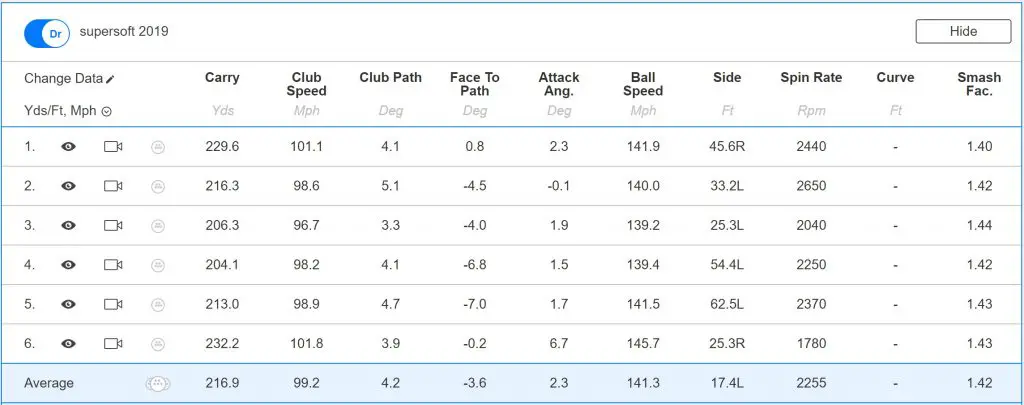
Iron Shots
For most iron shots, I didn’t see a big difference in terms of distance. The softer compression of the Supersoft makes less of a difference in ball speed as the club speed goes down. So, of course, if you are swinging your 7 iron at 100mph, then you’ll see a bigger difference between the two balls than I did.
Here are my numbers with a 7 iron from the Chrome Soft.
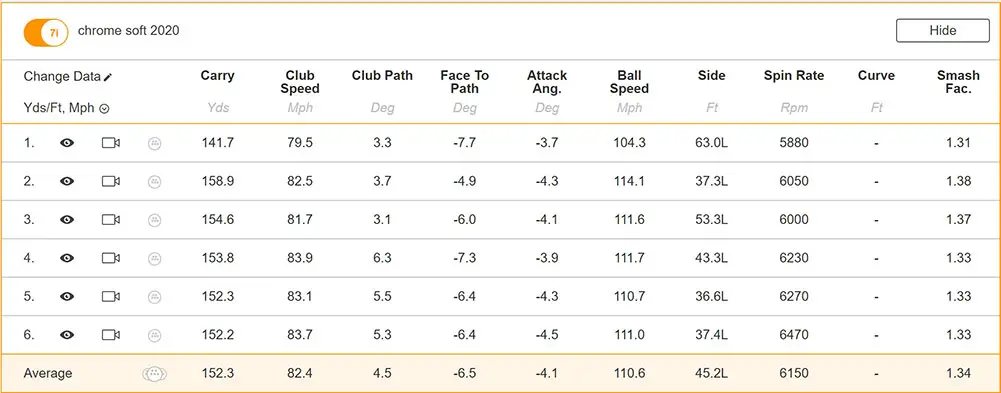
Now let’s look at the 7 iron numbers from the Supersoft.
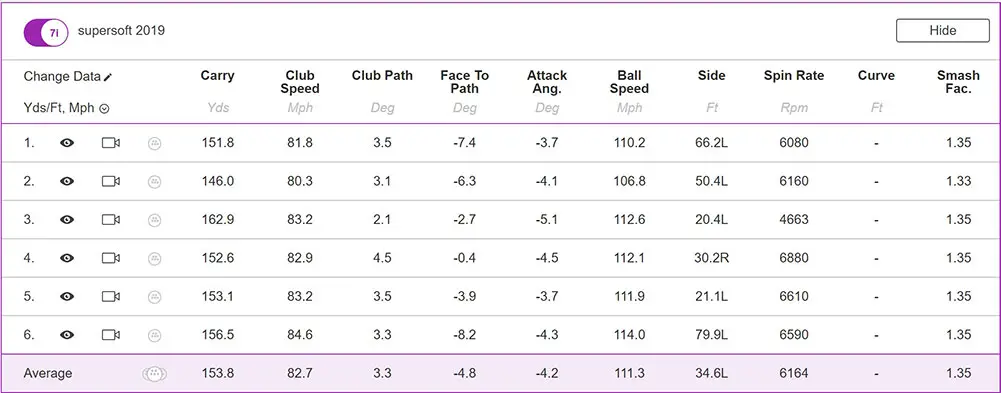
When it came to distance, ball speed, and spin, I saw minimal differences between the two golf balls with the 7 iron.
To get a complete picture, here are my numbers with the 54° wedge. The results were similar to the 7 irons with minimal difference between the two for me.
First, with the Chrome Soft.
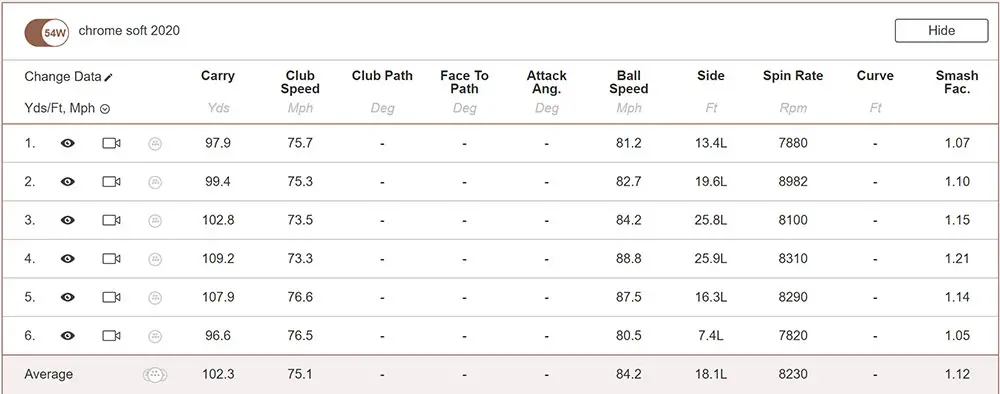
And with the Supersoft. You’ll see a slight increase in distance with the Supersoft. There are a couple of explanations for that. The most likely is that it is just variance in how I hit the ball since I’m not a robot.
It could also be that the Supersoft’s low compression meant more energy transfer for shorter shots because even with the wedge, I was able to compress the ball. I wouldn’t call this a good thing though, since maximizing distance is not the goal of a wedge…consistency is.
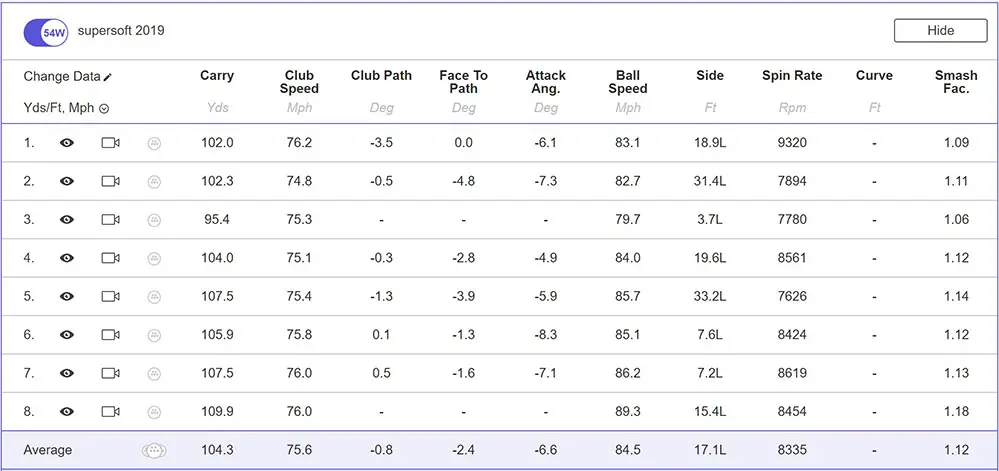
And on that topic of consistency, I did notice something when testing the balls that could prove an important factor for some players. There was a difference in the shot dispersion that was the same with the wedge and the 7 iron.
With the Chrome Soft, I had a nice tight grouping with both clubs.

However, when I tested the Supersoft (and removed the mishits), I got a decidedly different result. Especially with the 7 iron, the dispersion was much wider. On the course, this means that similarly struck shots could give varying results. That’s not a great thing for approach shots.

Of course, this can be a result of strike inconsistency and not the balls, but I think the differences were significant enough that I wanted to share them with you.
My opinion about what might have caused this difference is that the soft compression of the Supersoft leads to a somewhat less consistent result off the clubface. This is likely less pronounced at slower swing speeds (another reason faster swing speed players shouldn’t be using the Supersoft).
Short Game
The Chrome Soft is the clear winner when it comes to short game shots.
The urethane cover of the Chrome Soft is much softer than the surlyn cover of the Supersoft and that means more spin with short greenside shots like chips and pitches.
What that means when you’re on the course is that the Supersoft will run out more when it hits the green on shorter shots. If you play courses with slow greens or prefer to play the roll, then this is no big deal. You will get some greenside spin with the Supersoft, just not nearly as much as the Chrome Soft.
The Chrome Soft is going to play very similar around the greens to a ProV1. You’ll be able to have the ball check up when needed so if you play a lot on fast greens, this is going to be helpful.
Who Should Use The Chrome Soft
The Chrome Soft is definitely for the better player.
But I don’t think all low handicap players would necessarily benefit from the Chrome Soft. Just like the Supersoft will actually lose ball speed and distance with swing speeds above 95mph, the 75 compression Chrome Soft is not likely to benefit player with very high swing speeds of about 110+ mph.
That being said, most mid to low handicap amateur players would be a perfect fit for the Chrome Soft if they like the soft feel. If you prefer a firmer feeling ball, you may want to look at the TaylorMade TP5.
You can click on the retailers below to compare prices and check availability…
Who Should Use The Supersoft
The Callaway Supersoft is one of the best selling Callaway golf ball models, and for good reason. It is perfect for a very large number of amateur golfers.
With the combination of soft compression and low spin, this ball is perfect for anyone with a driver swing speed of 95mph or less who wants to add some distance and keep the ball in the fairway.
Of course price is a factor as well. Coming in at about half the price of a Chrome Soft, the Supersoft is going to be a lot easier on the wallet. Beginners and high handicap players on a budget should keep this in mind if you tend to lose a lot of balls during a round. You’re better off spending less on golf balls and saving up for lessons, because the expensive ones won’t make much of a difference.
You can click on the retailers below to compare prices and check availability…
